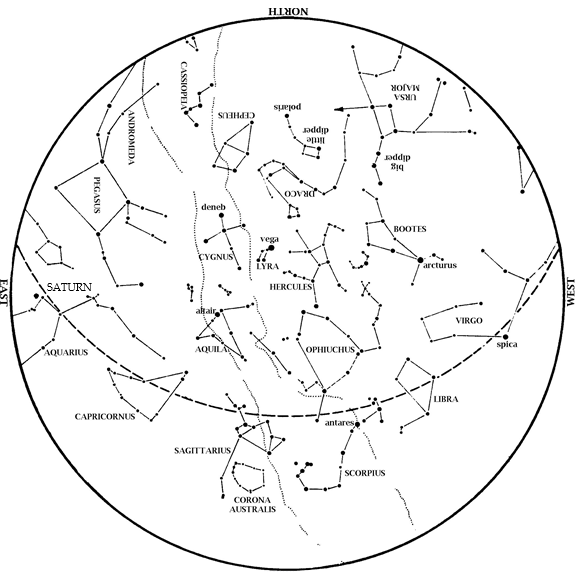Editor’s Note: The month of August brings the Perseid meteor shower. HMNS Astronomer James Wooten explains what to expect with upcoming sky happenings.
Saturn is now a late evening object! It rises in the east-southeast by 10:11 pm on August 1 and by 8:15 (during twilight) on August 31. Saturn is up literally all night long on September 7.
Venus also begins to emerge into the evening sky this month. Look for low in the west near the point of sunset, especially late in the month.
Jupiter is high in the east at dawn and outshines all the stars we ever see at night.
Mars is also in the morning sky, in the east at dawn. Mars brightens each morning this month as it overtakes Jupiter. This happens on August 14, when Mars passes about 1/3 of one degree from the giant. (Mars will be much dimmer than Jupiter.)
The Big Dipper is above and to the left of the North Star, with its handle pointing up. From that handle, you can ‘arc to Arcturus’. Arcturus is the brightest star we see on August evenings.
The Summer Triangle is high in the east at dusk. This consists of Deneb, Vega, and Altair, the brightest stars in Cygnus, Lyra, and Aquila respectively. Scorpius, the Scorpion, is in the south, with the ‘teapot’ of Sagittarius to his left. When you face between these two constellations, you face the direction of the galactic center, which all stars in the Milky Way orbit. The Great Square of Pegasus rises in the east, heralding the coming autumn.
If you are far enough from bright city lights, you might look for the Milky Way band. This band is brightest near the galactic center and extends from there right through the Summer Triangle. In fact, every star we ever see in the sky with the naked eye is in our Milky Way. Indeed, our galaxy is so big that only stars relatively close to us appear as distinct stars; the rest of our galaxy blurs out and appears as the Milky Way band across our sky. For example, Deneb is about 2600 light years away, which is quite far. The entire Milky Way, however, is 100,000 light years across, making Deneb one of our relative ‘neighbors’. Thus, we see our Milky Way as a blur in the background with stars like Deneb (and Vega, Altair, Arcturus, etc.) in the foreground.

The Summer Triangle is high overhead. This consists of the brightest stars in Cygnus, Lyra, and Aquila. Scorpius, the Scorpion, is in the south, with the ‘teapot’ of Sagittarius to his left. From the Big Dipper’s handle, ‘arc to Arcturus’ and ‘speed on to Spica’ in the southwest. Saturn is in the southeast at dusk and up all night long next month. The Great Square of Pegasus rises in the east, heralding the coming autumn.
Moon Phases in August 2024
New Aug 4, 6:13 a.m.
1st Quarter Aug 12, 10:19 a.m.
Full Aug 19, 1:26 p.m.
Last Quarter Aug 26, 4:26 a.m.
The Perseid meteor shower peaks every year in mid-August as Earth passes through debris left by Comet Swift-Tuttle. This year, the peak (August 11-13) coincides with a first quarter Moon. Look for, on average, one meteor per minute, with more meteors visible as dawn approaches.
The George Observatory remains closed due to Beryl cleanup until at least August 16, 2024.
Clear Skies!
Miss out on last month’s sky happenings? Find our July entry here.






